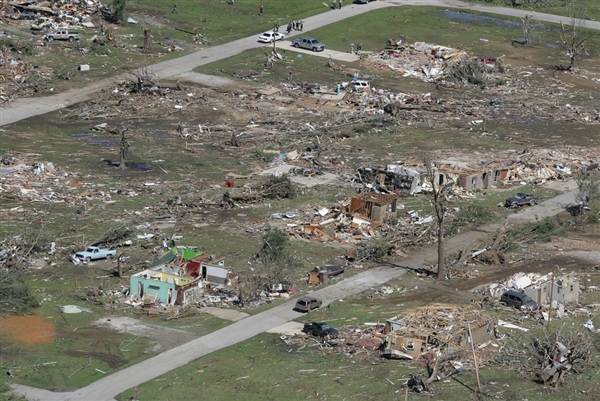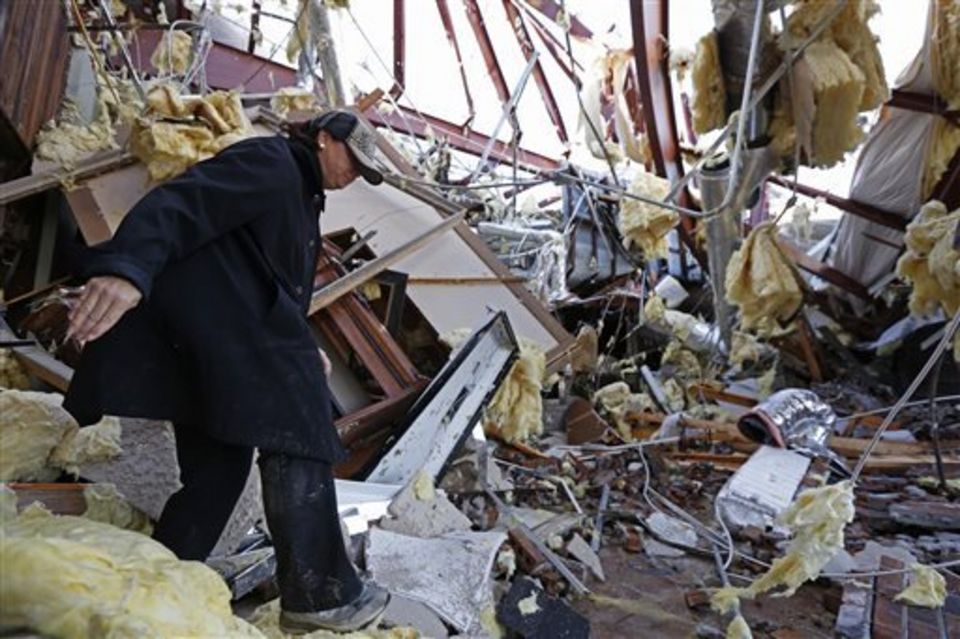
SMITHVILLE – (AP) A few days before a tornado ripped apart her town, a frail and nearly blind woman named Ruth Estis stared through a magnifying glass as she slowly scratched out a letter to her granddaughter.
She never got around to mailing it before the storm blew through on April 27, 2011. And there was little chance she could escape the deadly twister.
Ruth and her husband, Roy “Peanut” Estis, hunkered down as the winds ripped apart their home. The tornado pulled Ruth from his arms and her body was found 20 yards away. She was 61. He died the next day. He was 63.
As the anniversary approaches , Smithville is recovering, but the pain of losing 16 people in a town of about 900 lingers. Those left to pick up the pieces cherish the mementos the winds left behind. Only a few items were salvaged from the wreckage of the Estises’ house. Most have more sentimental value than anything else, like one of Roy’s shotgun shells and some tools.
Also found was that unmailed letter, written to Savannah Brown, just 12 years old at the time. It was, her family says, like a gift from heaven.
“You’re so sweet and kind to me and that alone means the world to me … I was the first one to put your hair up,” the letter says.
Savannah gently held the framed letter on a recent afternoon, her dark hair pulled up in a ponytail.
“My best friend,” she says.
Ruth’s only sight was a little peripheral vision, which made writing difficult because she had to look through a magnifying glass out of the corner of one eye. That makes the letter so much sweeter.
“I think it was the longest letter she ever wrote to me,” Savannah says. “I think that’s cool.”
The storms that raked the South last April produced 67 tornados in Mississippi and killed 37 people in the state. Many of the fatalities were from the twister that hit Smithville. It destroyed the town’s police department, city hall, the post office, the school, the only grocery store and four of its five churches. More than 150 homes were damaged or destroyed in the town.
It was the sixth deadliest tornado in Mississippi history, an F5 with winds topping 200 mph, according to the National Weather Service. The deadliest tornado on record in the state was one that killed 58 people on Feb. 21, 1971.
Mississippi Emergency Management Agency spokesman Jeff Rent said state and federal officials have provided $10.6 million in assistance to people in Mississippi hit by last April’s tornados, most of it for housing. Just under $1.8 million was distributed in Monroe County, home to hard-hit Smithville. However, those numbers don’t capture the total cost of the storms’ destruction because MEMA doesn’t track damages covered by insurance.
Officials also provided another $10 million in low-interest loans. And the Federal Emergency Management Agency obligated some $23 million to help government entities and nonprofit organizations pay for 630 projects, like debris removal and repairs to public buildings and infrastructure.
But in storms like these, dollar signs don’t tell the whole story. The emotional toll can linger long after repairs are made Just ask the Brown family, whose house has been repaired.
The Estises’ daughter Shellie Brown was with Savannah and her 6-year-old son, Garrett, when the storm pushed a tree on their house. Her husband, Dwayne, was at work, so she and the kids set out on foot to find her parents across town.
They found Roy in what “looked like Armageddon,” staring at the debris-covered town cemetery, where he and his wife would soon be together again.
“All I could say was, `Daddy,”’ Brown recalled. “He said, `I’m fixing to go.”’
Roy was taken to a hospital, but his injuries were too much to overcome.
“We told him how proud we were that he stayed with Mom. That it was a true act of love. That he showed us what marriage and loyalty are all about. We told him everything was OK. But it really wasn’t,” Brown said, tears streaming down her face.
Brown pauses, pushes back a blond curl and takes a deep breath. “Before Daddy passed, it looked like he smiled at me.”
Michelle Bond, Smithville’s recovery manager, recalls an especially poignant moment for her when she took her children to school for the first time after the storm. They were nervous about going to Hatley Attendance Center, which was Smithville’s biggest rival. When Bond and her children pulled up, they saw Hatley’s faculty wearing Smithville’s colors, maroon and white.
“And there were signs that said, `We’re all Seminoles today,”’ Bond recalled. “I just bawled.”
Now Smithville students go to school in a compound of 44 temporary, double-wide trailers. Rows of concrete storm shelters sit nearby. Rebuilding the school was delayed while the Mississippi Department of Archives and History considered saving a building from the 1930s. That plan was eventually abandoned and officials hope to have a new school by Fall 2013.
“We have some kids, when there’s a cloudy day, they don’t want to come to school. It just takes time to get over it,” Bond said.
There are signs of recovery here, but many reminders of the devastation. Wildflowers grow around concrete slabs where neighborhoods once stood. Smithville’s post office boxes are in the corner of a Texaco gas station. The Piggly Wiggly grocery store hasn’t come back.
It may be slow, but the people of Smithville say there has been progress. Three of the four churches destroyed have essentially built back. The other one, Smithville Baptist, recently broke ground at a new location where the congregation plans to build a bigger building than the one destroyed. Church officials are projecting a cost of around $3 million, with insurance covering about two-thirds.
“Our insurance was very, very good to us,” said Pastor Wes White, known to his congregation as Brother Wes.
For now, members of Smithville Baptist meet in two warehouses. A stained glass window, one of the only parts of the old church that survived, hangs from a wall in the building used for church services. It depicts Jesus with outstretched arms.
When the tornado hit, White was in the red brick building with some residents from a nearby mobile home park who had sought shelter. White says they clung to one another “like a mass of humanity” as the church disintegrated, and somehow all survived.
On a recent Wednesday night, White preached about making time in the rush to rebuild.
“What will give me time in a chaotic world?” White asked. “Hope. Hope is the rudder that guides us.”
That hit home for church members Larry Seales and his wife Renee. The tornado destroyed their house and also killed her parents.
Renee Seales finds comfort that her parents, Elvin and Laverne Patterson, were found nearly side-by-side after the storm. He was 80. She was 77.
They were well-known in town. He was often found at a local diner, sitting with a group of friends at a round table affectionately known as the “liar’s table.” Vern had played Minnie Pearl in the town’s annual festival to celebrate native son, Rod Brasfield, a comedian of Grand Ole Opry fame.
“My Daddy called her Vern. He couldn’t do anything without hollering, `Vern, Vern.’ So I guess it’s good they went together,” Renee said.
There’s plenty of hope in Smithville, but there are a lot of things people need.
They want normalcy. They want a grocery store. They want their kids to go to a school that’s not nicknamed “Smithville Trailer Park.”
Perhaps most of all, they long for what they can’t have back. Shellie Brown says she may never get over losing her parents.
“The tornado took a part of me with it.”




Be the first to comment